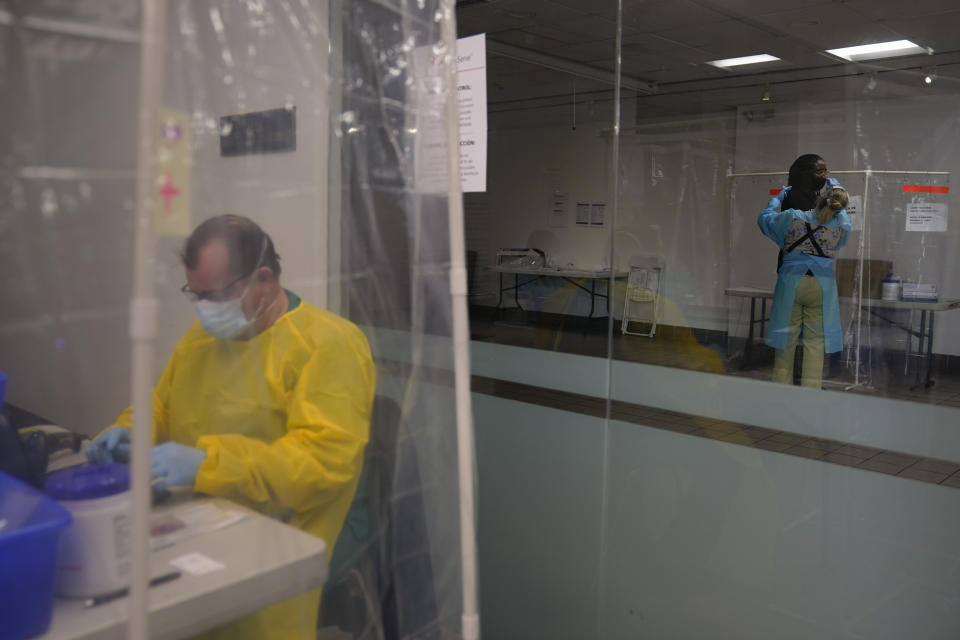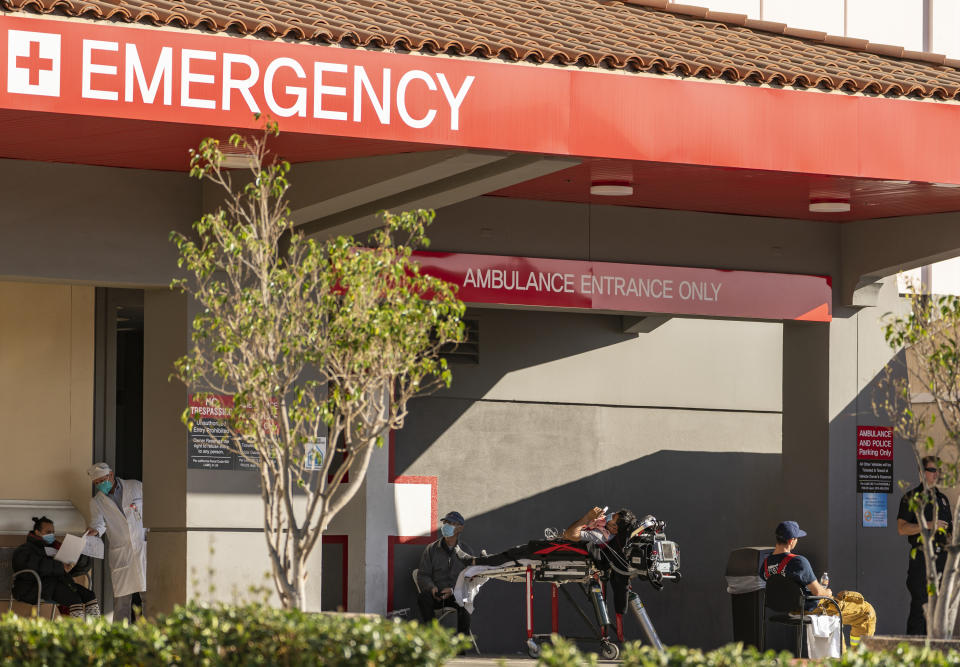'Surge on top of a surge' to challenge California hospitals
LOS ANGELES (AP) — Coronavirus hospitalizations are stabilizing in parts of California, but patients are still overwhelming hospitals in a large swath of the state, leading Gov. Gavin Newsom to warn Californians to brace for the effect of a “surge on top of a surge" from recent holiday travel.
Intensive care units in Southern California and the agricultural San Joaquin Valley have no capacity remaining, according to state figures, and Newsom said it was “self-evident” his latest stay-at-home order would be extended Tuesday in places where hospital ICUs have less than 15% capacity.
Newsom said Monday that even with hospital admissions plateauing in some places, the state was destined to move into a “new phase” that it's been preparing for as it sets up hospital beds in arenas, schools and tents, though it is struggling to staff them.
“As we move into this new phase, where we brace, where we prepare ourselves for what is inevitable now ... based on the travel we have just seen in the last week and the expectation of more of the same through the rest of the holiday season of a surge on top of a surge, arguably, on top of, again, another surge,” Newsom said.
State officials also notified hospitals that the situation is so dire they should prepare for the possibility that they will have to resort to “crisis care" guidelines established earlier in the pandemic, which allow for rationing treatment.
The surge of infections is due in large part to Thanksgiving travel and celebrations, which happened despite warnings from health officials not to gather because the nation's most populated state was already seeing explosive growth in cases.
It's created the greatest challenge for California’s health system since the pandemic began, with case counts, hospitalizations and deaths from COVID-19 regularly breaking records.
While daily coronavirus cases were down to 31,000 Monday from a seven-day average of above 37,000, it was likely due to a lag in data from the weekend, Newsom said.
Models used for planning show hospitalizations more than doubling in the next month from about 20,000 to more than 50,000.
The state has several makeshift hospitals that are taking patients, but more health care workers are needed to staff them, the Democratic governor said. It has deployed more than 1,000 people to 116 hospitals and other facilities through a volunteer corps or the National Guard. On the upside, Newsom said California finally expects to receive more of the traveling health care workers it had requested in anticipation of the shortage.
The Department of Public Health is sending an emergency medical team to Los Angeles to help better distribute patients among hospitals. Some hospitals are well above capacity and others are below, Newsom said.
Over the weekend, most Los Angeles County hospitals reached a crisis point where they had to divert ambulances because they didn't have beds available.
“The sad reality is that all indicators tell us that our situation may only get worse as we begin 2021,” county Public Health Director Barbara Ferrer said.
Los Angeles County, which accounts for a quarter of California's nearly 40 million residents, has about 40% of the state's 24,000 deaths. The county is approaching a milestone of 10,000 deaths.
“These are figures that can’t be normalized,” county Supervisor Hilda Solis said. “Just like the sound of ambulance sirens, we can’t tune this out.”
Travel over Christmas was expected to create another spike in cases. It may not show up for several weeks because of a lag from the time someone is exposed to the virus to when they get test results and ultimately get sick enough to require hospitalization.
Although there are indications more people are heeding stay-at-home orders that apply to all of the state but northernmost rural counties, there was a bump in air travel in Los Angeles similar to Thanksgiving.
The number of passengers flying out of Los Angeles International Airport was down about 70% from last year between Dec. 21 and 27, but the high of 43,000 on Dec. 23 was only 60% below last year’s figures, spokesman Heath Montgomery said. That was about as busy as the airport has been since the pandemic began.
The number of passengers departing San Francisco International Airport from Dec. 20 to 27 was down 80% from last year, spokesman Doug Yakel said.
The state's health secretary, Dr. Mark Ghaly, urged people not to gather for New Year's, which would further compound problems. Surveys about a month ago indicated only 30% of Californians were going to alter plans to gather or travel, but more recent surveys show 50% to 60% were changing their plans, he said.
“Things that were a month ago or two months ago a low-risk activity today are really high risks because of the level of COVID that’s circulating in our communities,” Ghaly said.
The surge comes amid an effort to vaccinate health workers and people at nursing homes and then expand to other groups, likely including teachers.
The state expects to have received 1.7 million doses of vaccine by the end of the week, Newsom said. He also announced that CVS and Walgreens pharmacies would begin vaccinating residents in nursing homes and assisted living facilities.
___
Associated Press writers Janie Har in San Francisco, Don Thompson in Sacramento and Stefanie Dazio and John Antczak in Los Angeles contributed.
___
This story has been corrected to show that California has nearly 40 million people, not 10 million.







